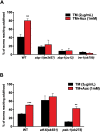Auxin confers protection against ER stress in Caenorhabditis elegans
- PMID: 33495210
- PMCID: PMC7875485
- DOI: 10.1242/bio.057992
Auxin confers protection against ER stress in Caenorhabditis elegans
Abstract
Auxins are plant growth regulators that influence most aspects of plant development through complex mechanisms. The development of an auxin-inducible degradation (AID) system has enabled rapid, conditional protein depletion in yeast and cultured cells. More recently, the system was successfully adapted to Caenorhabditiselegans to achieve auxin-dependent degradation of targets in all tissues and developmental stages. Whether auxin treatment alone has an impact on nematode physiology is an open question. Here we show that indole-3-acetic acid (IAA), the auxin most commonly used to trigger AID in worms, functions through the conserved IRE-1/XBP-1 branch of the Unfolded Protein Response (UPR) to promote resistance to endoplasmic reticulum (ER) stress. Because the UPR not only plays a central role in restoring ER homeostasis, but also promotes lipid biosynthesis and regulates lifespan, we suggest that extreme caution should be exercised when using the AID system to study these and related processes.
Keywords: Auxin; ER stress; Tunicamycin; Unfolded Protein Response.
© 2021. Published by The Company of Biologists Ltd.
Conflict of interest statement
Competing interestsThe authors declare no competing or financial interests.
Figures



References
-
- Bischof, L. J., Kao, C.-Y., Los, F. C. O., Gonzalez, M. R., Shen, Z., Briggs, S. P., van der Goot, F. G. and Aroian, R. V. (2008). Activation of the unfolded protein response is required for defenses against bacterial pore-forming toxin in vivo. PLoS Pathog. 4, e1000176 10.1371/journal.ppat.1000176 - DOI - PMC - PubMed
Publication types
MeSH terms
Substances
LinkOut - more resources
Full Text Sources
Other Literature Sources
Research Materials

